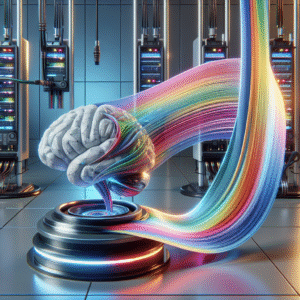Have you ever wondered how technology can change the way we learn? As I think about the educational landscape today, one innovation stands out — Augmented Reality (AR). It’s reshaping how we interact with information, making learning not just informative but also engaging and fun.
What is Augmented Reality?
Augmented Reality, or AR, is a technology that superimposes digital information — images, sounds, and text — onto the real world. It enhances our view of reality, blending what we see with virtual elements. Unlike Virtual Reality (VR), which completely immerses users in a digital environment, AR allows me to interact with both the physical and digital worlds simultaneously.
For example, I could point my smartphone at a historical artifact and see a holographic representation of how it was used in its time. This merging of real and virtual resources not only captivates my attention but fosters a deeper understanding of the subject.
The Role of AR in Learning
Education has always been about communication and interaction. With the onset of AR, it transforms traditional methods by engaging me in a more immersive experience. By placing information directly in my field of view, AR encourages active learning, stimulating my curiosity and enhancing retention.
In classrooms using AR, students can visualize complex concepts that are otherwise abstract or hard to grasp. Whether it’s exploring the intricacies of human anatomy or unraveling the mysteries of ancient civilizations, AR helps me see things from a new perspective.
Benefits of AR in Education
Enhanced Engagement and Motivation
One of the most striking benefits I’ve noticed is how AR boosts engagement. When learning becomes interactive and visually appealing, I find myself more motivated and eager to participate. Engaging students through AR not only piques my interest but also transforms mundane lessons into exciting experiences.
Improved Retention of Information
Studies suggest that when I interact with information using AR, I’m more likely to remember it. This enhanced retention of knowledge stems from the fact that I am not just passively receiving information; I’m actively involved in the learning process. By integrating visual and tactile experiences, AR helps solidify concepts in my mind.
Accessibility to Diverse Learning Styles
Not everyone learns the same way. I appreciate that AR caters to various learning styles, whether I’m a visual learner who benefits from diagrams and videos or a kinesthetic learner who thrives on hands-on activities. This inclusivity ensures that all students, including myself, can find ways to engage with educational content that resonate with us.
Practical Applications in Various Subjects
Science Education
In science classes, AR allows me to witness virtual experiments and simulations. For instance, I can perform complex chemistry experiments safely and observe reactions without the dangers associated with real chemicals. This practical application demystifies scientific concepts, making them more approachable and less intimidating.
History and Social Studies
When it comes to history, AR transports me to different times and places. By using AR applications, I can “visit” historical landmarks, observe reenactments, and even interact with holographic figures of historical characters. This experience brings history to life, adding context and depth to what I learn in textbooks.
Mathematics
Mathematics can often be abstract and challenging. With AR, I can visualize mathematical concepts in tangible ways. For example, I can manipulate three-dimensional shapes to understand geometry better. This visualization transforms math into a hands-on experience, helping me grasp complex subjects more effectively.
Overcoming Challenges in Education with AR
While AR offers numerous benefits, I understand that implementing this technology isn’t without challenges.
Cost and Accessibility
One primary concern is the cost of AR technology. Not all schools have the budget to provide AR tools and devices, which might create disparities in access to quality education. As educators and institutions advocate for funding and resources, it’s crucial to find sustainable ways to integrate AR into the learning experience.
Teacher Training
Another challenge arises in ensuring that educators are adequately trained to utilize AR in the classroom. I realize that without the right support and understanding of AR technology, teachers may struggle to integrate it effectively into their lessons. Continuous professional development is essential to equip educators with the tools and confidence they need.
The Future of AR in Education
Expansion of AR Tools
Looking forward, I can imagine a future where AR tools become more widespread and affordable. As technology advances, more educational apps and platforms will emerge, offering innovative ways to enhance learning experiences. I can easily see more apps designed to cater to specific subjects, tailoring education to my needs and interests.
Integration with Artificial Intelligence
Another exciting prospect is the integration of AR with Artificial Intelligence (AI). As AI becomes more sophisticated, it can adapt AR experiences to my learning pace and style. This customization could make education even more personalized and effective, allowing me to thrive in a way that traditional learning methods may not offer.
Global Collaborative Learning
Imagine a classroom where I can collaborate with students from different parts of the world through AR. This global perspective enriches my learning experience, fostering cultural exchange and understanding. AR could create a virtual study group where I can work together with my peers on projects, regardless of geographical boundaries.
Bridging the Gap Between Theory and Practical Skills
As education continues to evolve, AR has the potential to bridge the gap between theoretical knowledge and practical skills. In vocational training, I can benefit from simulated environments, practicing skills in a safe space before entering the workforce. This hands-on training will better prepare me for real-world challenges.
Real-World Examples of AR in Education
Case Study: The Merge Cube
One of the innovative tools emerging in the AR space is the Merge Cube. I’ve seen how this interactive learning tool enables students to hold virtual objects in their hands, transforming the way I learn science and history. By using a simple smartphone app, the Merge Cube turns the mundane into the extraordinary, allowing me to visualize and interact with concepts in real-time.
Case Study: Google Expeditions
Another incredible application is Google Expeditions, which allows me to take virtual field trips. With this platform, I can explore different environments and historical landmarks as if I were really there. This eliminates geographical limitations, giving me the chance to experience the wonders of the world without leaving the classroom.
Case Study: zSpace
zSpace takes learning to another level by offering an AR and VR experience in education. With their systems, I can engage in lessons that blend both digital and physical elements. This hands-on learning model caters to my curiosity and promotes deeper understanding, especially in anatomy and engineering.
Conclusion
In closing, I believe that Augmented Reality is transforming education in ways we could only dream of a few years ago. As I think about how it enhances engagement, accessibility, and practical learning experiences, I can’t help but feel excited about the future of education.
The integration of AR is not without its challenges, but I find hope in the continued exploration and development of this technology. As more educators embrace AR, it can illuminate paths to enriching learning experiences for students like me.
As we stand on the brink of significant technological advancements, I can only imagine the impact AR will have as it continues to evolve. Education is bound to become more interactive, inclusive, and engaging, making the acquisition of knowledge a thrilling adventure for everyone involved. With AR, the possibilities for my learning journey are limitless.






